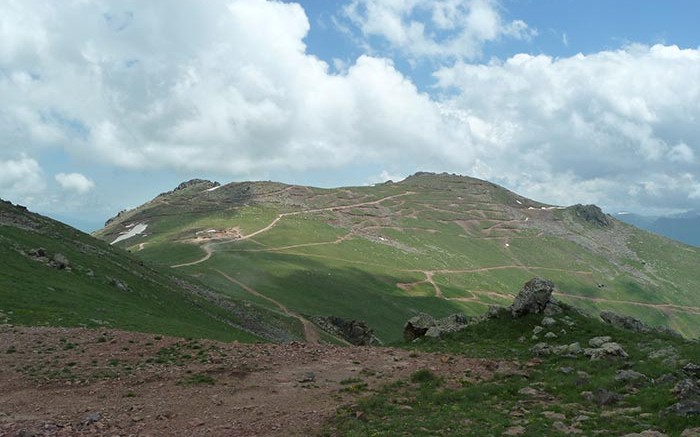VANCOUVER — Shares of Lydian International (TSX: LYD; US-OTC: LYDIF) were on the rise after news that the company cleared the final permitting hurdle at its wholly owned Amulsar epithermal gold deposit, 170 km south of Armenia’s capital city of Yerevan. On Nov. 27 the company announced that the Ministry of Energy and Natural Resources had granted approval of the mining right for the project, which should pave the way for construction and a 2017 production target.
The approval marks the culmination of a year’s work with the Armenian government. Lydian’s original heap-leach plan was scrapped in July 2013 when officials modified the area defined as the “catchment basin” for Lake Sevan — the country’s largest freshwater resource — to encompass the proposed location for the Amulsar heap-leach facility.
The unexpected delay forced Lydian to rejig an ongoing feasibility study to accommodate the design changes, with the results reported in September.
The re-vamped site layout was endorsed by the Armenian working group, as well as the three townships that will be affected by the development: Jermuk, Gorayk, and Gndevaz.
“We’ve recently provided a much clearer development picture in terms of Amalsur’s potential. It’s a significant asset we believe we can leverage to become a mid-tier gold producer. The most significant recent changes have been to relocate the heap-leach facility,” president and CEO Howard Stevenson noted during a third-quarter conference call.
“The new location has been endorsed by the government working group composed of members from various ministries, and is around 6 km from the crushers. It’s actually in a far more favourable location in terms of construction than it had been previously,” he added.
Lydian has received various permits in the past, but the final approval is the first time it will have a mining right and environmental impact assessment (EIA) aligned with the underlying assumptions of the feasibility study and pending environmental and social impact assessment (ESIA).
The approval covers all project infrastructure, including: the location for crushers, conveyor and heap leach facility; a mining permit applicable to all three defined pits; definition of the area within which operating activities may take place; and a mining agreement that outlines the nature and duration of operations.
Lydian has made a few other design alterations under its most recent study. The company notes that measured and indicated resources have jumped 12.1% since the last study to 122.4 million tonnes grading 0.77 gram gold per tonne for 3.03 million contained oz.
The project’s 10-year mine life is based on proven and probable reserves of 102 million tonnes averaging 0.77 gram gold and 3.6 grams silver for 2.5 million oz. contained gold and 11.9 million oz. contained silver.
The company also tossed out a staged-build approach. Nominal throughput of 10 million tonnes per year is now planned from the outset, with processing of higher-grade ore during the first five years. Lydian is hoping the heightened cash flow generated through the early part of Amulsar’s life can help finance the US$426-million development costs.
“The initial capital isn’t onerous and the mine life is sufficient to meet the banks’ reserve requirements. We see a number of commercial banks — as well as the International Finance Corp. (IFC) and European Bank for Reconstruction and Development (EBRD) — as perspective-funding sources,” commented chief financial officer Douglas Tobler, who mentioned alternate financing pools like streaming agreements.
“Clearly the project should be able to carry a sizable debt project facility, which we think will be somewhere in the realm of 70% of the initial capital requirement,” he continued.
Amulsar could produce an average 200,000 oz. gold per year at all-in sustaining cash costs of US$701 per oz. assuming 84% gold recoveries and a 2.8-to-1 strip ratio. The mine would generate US$574 million in after-tax operating cash flows over its initial five-year run.
Assuming a US$1,250 per oz. gold price the project would feature a US$306-million after-tax net present value at a 5% discount rate, along with a 20.2% internal rate of return.
Lydian counts the EBRD and IFC as shareholders, with the EBRD picking up 3 million shares of the company in an April private placement at $1 per share. Lydian reported US$15.5 million in working capital at the end of September.
The company drafted its international ESIA in late September, and expects to release the results by year-end. The process will allow the company to meet the Equator Principles, which are environmental and social frameworks that cover 70% of international project debt in emerging markets.
“The mayors of the three affected towns have all submitted formal letters of support. We’re in the final stages of our ESIA, which is required to be over and above Armenian standards,” Stevenson noted. “We’re in almost daily contact with the relevant ministries, and we’re ensuring that the process moves forward at a reliable pace.”
Lydian shares have traded within a 52-week range of 46¢ to $1.48, and jumped 25%, or 12¢, after Amulsar’s permit approval, en route to a 62¢ close at press time. The company has 152.2 million shares outstanding for a $94-million market capitalization.
BMO Capital Markets analyst Andrew Kaip — who has a stock “outperform” rating and $1.10 per share price target on Lydian — wrote on Nov. 27 that “approval of the mining permit reflects the final step in the permitting process, and comes in slightly ahead of schedule. The approval enables [the company] to construct all [crushers, conveyors and heap-leach facility] infrastructure and mine the open pits, as outlined in the feasibility study.”


Be the first to comment on "Lydian scores final mine permit at Amulsar"